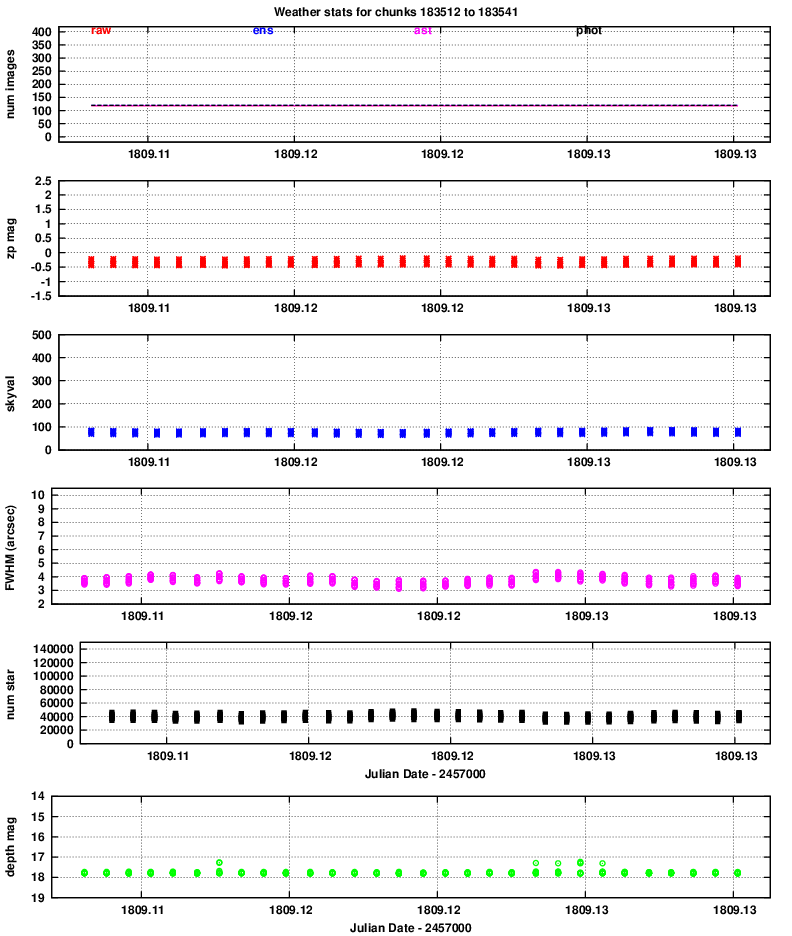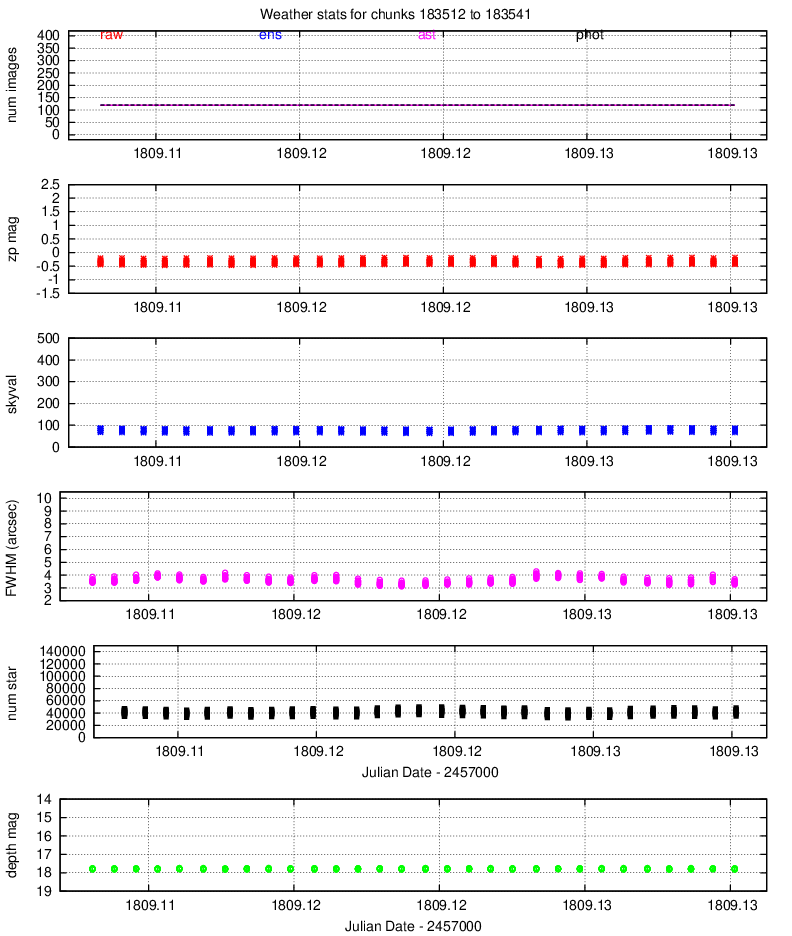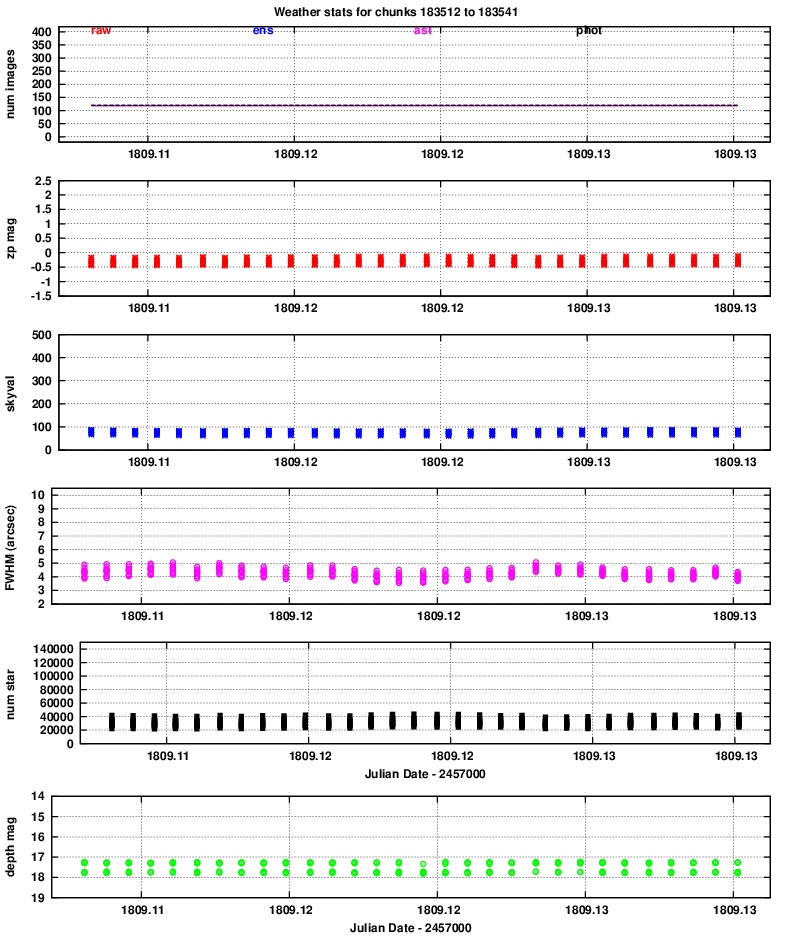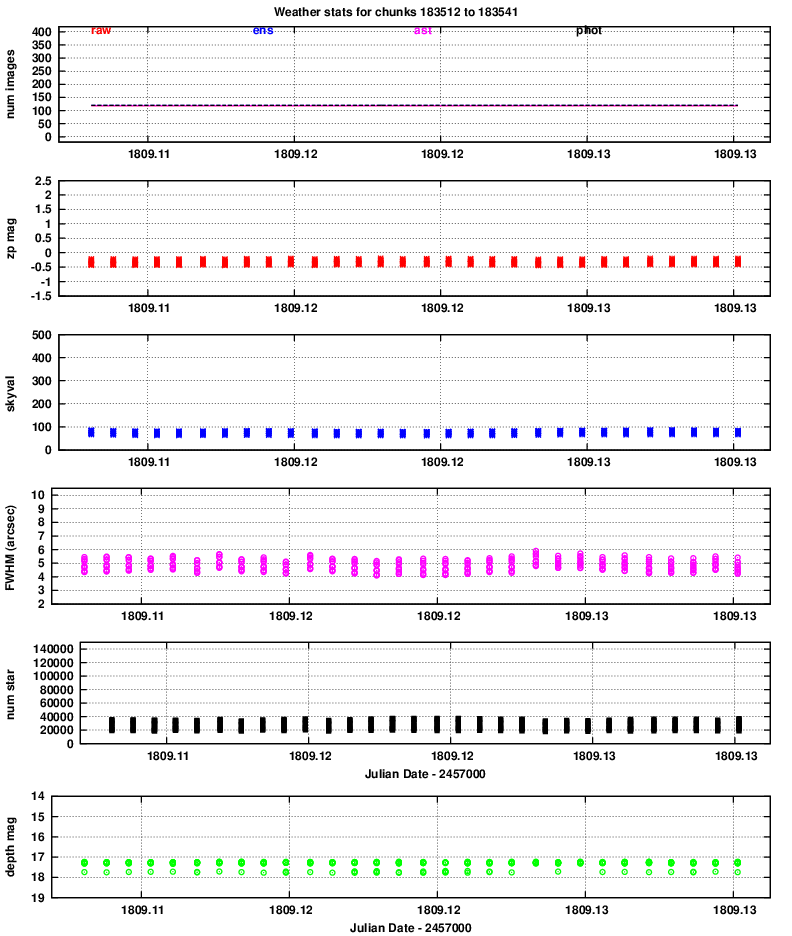
I have analyzed a dataset from a subset of the 84 chips; only chips 11-32 in each quadrant were active. In addition, the run covers only about 32 minutes. Conditions were good, but promising transient candidates were found. However, the software did flag one possible transient candidate which turned out to be asteroid (76309) Ronferdie, at magnitude V = 18.1 or so.
The dataset "20191121" is based on images acquired during UT 2019 Nov 21. The images cover the span of time
2458809.1077180 ≤ JD ≤ 2458809.1304885
which is only about 32 minutes; so, this is a very short period of time, much less than a full night. The dataset includes images from all 4 quadrants and only 10 of the chips in each: chips 11, 12, 13, 14, 21, 22, 23, 24, 31, 32.
The FITS headers of one of these images states, in part:
OBJECT = 'J0342+1704_dith1' / object name EXPTIME = 59.988480 / [s] total exposure time TELAPSE = 60.500020 / [s] elapsed time EXPTIME1= 0.499904 / [s] exposure time per frame TFRAME = 0.500000 / [s] frame interval in seconds DATA-FPS= 2.000000 / [Hz] frame per second DATA-TYP= 'OBJECT' / data type (OBJECT,FLAT,DARK) OBS-MOD = 'Imaging' / observation mode FILTER = 'BLANK' / filter name PROJECT = 'Earth Shadow 2Hz Survey' / project name OBSERVER= 'Noriaki Arima' / observer name PIPELINE= 'wcs,stack,raw' / reduction pipeline templete
The images were reduced and cleaned by others; I started with clean versions of the images. Each set of 120 images was packed into a single FITS file, covering a span of (120 * 0.5 sec) = 60 seconds. These "chunk" files were located on shinohara in the directory
/gwkiso/tomoesn/raw/20191121
with names like
rTMQ1201911210018351211.fits
These names can be decoded as follows:
r stands for "reduced" ??
TMQ2 means "Tomoe data, part of quadrant 2"
20191121 means year 2019, month 11, day 21
00183512 means chunk index 00183512 (increases with time)
11 means chip 11
.fits means a FITS file
I'll refer to each of these "composite" files as a "chunk".
There are typically 30 chunks for each chip, and a total of 1200 chunks in the entire dataset. Each chunk file was 1083 MByte, so the total volume of the chunk files was about 1300 GByte = 1.3 TByte.
I ran a slightly modified version of the Tomoe pipeline on the images; it was not the same as that used to analyze the 2016 images discussed in the transient paper for two reasons:
The main stages in the pipeline were:
The output of the pipeline includes a copy of each FITS image, plus a set of ASCII text files which include both the raw, uncalibrated star lists, and the calibrated versions of those lists, as well as the ensemble output.
On the machine shinohara1.kiso.ioa.s.u-tokyo.ac.jp, I ran the pipeline using a single thread; in other words, each chunk, and each image, was sent through the calculations sequentially. There was no attempt at parallel processing.
First, I ran the pipeline only on quadrant 1. It took an average of about 1.46 minutes per chunk. Next, I tried running three pipelines simultaneously, in order to process quadrants 2, 3, and 4 at the same time. During this test, the load average on the machine was reported to be about 3.1. The time taken per chunk was 1.91, 1.82, and 1.78 minutes, respectively, for quadrants 2, 3, 4. So, running three pipelines at the same time meant that each one took a bit longer than a single pipeline by itself, but the overall processing took about 44% of the time it would have take to run 3 pipelines in a serial manner.
After running the pipeline to reduce the data, clean the images, find and measure stars, calibrate them astrometrically and photometrically, I used a script to look at properties of the data over the course of the night. You can read more about the "weather" in another note.
Below are links to the graphs produced for each of the 4 quadrants.
Quadrant 1:

Quadrant 2:

Quadrant 3:

Quadrant 4:

zp = (instrumental_mag) - (calibrated_mag)
Large positive values indicate extinction due to the atmosphere or clouds.
Very small changes means "no clouds tonight."
It is clear that the FWHM for quadrants 3 and especially 4 is (again) considerably larger than that of quadrants 1 and 2.
The images typically show stars down to almost mag V = 18. We can see that, again, quadrants 3 and especially 4 have slightly lower quality than quadrants 1 and 2.
These patterns are the same as seen in night 20191120.
After all the data had been calibrated, I ran the "transient_a.pl" script, which applies the rules described in the Tomo-e transient search paper to look for sources with only a brief existence. The code also computes a "control time" for the dataset.
The software found 26, 23, 27, and 17 candidates in quadrants 1, 2, 3, and 4, respectively. I created a web page showing the properties of these candidates in each quadrant:
The entry for each candidate includes some information about the chunk in which it appears, its position in (x,y) pixel coordinates and (RA, Dec) coordinates, and its magnitude. The "variability score" describes the ratio of the standard deviation of its magnitudes away from the mean to the standard deviation from the mean of stars of similar brightness; so, a high score means the object is varying from frame to frame more than most objects of similar brightness.
The entries for quadrants 2, 3, and 4, contain columns listing the magnitudes of any objects at this position (to within 5 arcsec) in the USNO B1.0 (avergage of R-band magnitudes) and in the 2MASS catalog (K-band magnitude). A value of "99.0" indicates that no source appears in the catalog as this position. You can see that the overwhelming majority of candidates do correspond to objects which were detected in one or both of these catalogs -- meaning that they are not true transients.
After these columns of text, the documents contain thumbnails of the images around the candidate. The thumbnails are oriented with North up, East left, and are 110 pixels (= 130 arcsec) on a side.
I found one candidate which seemed promising: in quadrant 3, the candidate labelled "00183528_14", which is detected at RA = 56.0076, Dec = +14.1346. That object does not match any star in the USNO B1.0 or 2MASS catalogs. Although the software noted it appeared only in 3 images of this chunk, I thought I could see it in some of the other images; moreover, the software detected it frequently enough in 7 other chunks to include it in their ensembles. Its position moved slightly from chunk to chunk:
# RA Dec mag maguncert chunk #----------------------------------------------------------------------------- 169 8.205 0.240 2 1.32 56.01006 14.13454 18.0684 0.2400 00183517_14 162 8.856 0.294 2 1.47 56.00903 14.13455 18.7017 0.2940 00183522_14 174 8.349 0.284 2 1.07 56.00816 14.13474 18.2373 0.2840 00183524_14 178 8.134 0.113 2 0.64 56.00841 14.13463 18.0688 0.1130 00183525_14 168 8.091 0.216 2 1.06 56.00763 14.13462 18.0053 0.2160 00183528_14 167 9.251 0.029 2 0.08 56.00676 14.13473 19.0890 0.0290 00183533_14 170 8.937 0.520 2 1.52 56.00551 14.13494 18.8365 0.5200 00183539_14 #-----------------------------------------------------------------------------
Both the positions, and the motion, match that of asteroid (76309) Ronferdie. The JPL Horizons system provides an estimate of V = 18.1 for this object, so it is somewhat fainter than the limiting magnitude in most chunks.
It is a good sign that the transient-finding software did detect this real object.
The table below shows the control times for each quadrant in this dataset:
quadrant control time (square degrees * sec)
V=13 V=14 V=15 V=16 V=17
-------------------------------------------------------------
1 4315 4315 4315 4315 1064
2 4315 4315 4315 4315 2243
3 4315 4315 4315 4315 0
4 4314 4314 4314 4314 14
total 17259 17259 17259 17259 3321
-------------------------------------------------------------
These control times are a bit smaller than those for each of the nights listed in the transient paper;